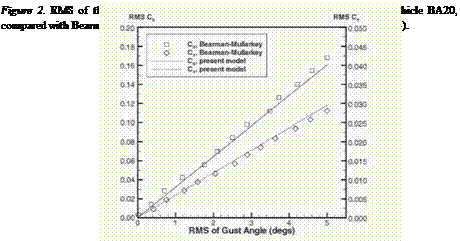Unsteady flow results
At each blade surface node, the unsteady pressure history for two vane passing periods is Fourier decomposed. Consequently, the second Fourier mode represents the vane passing frequency. For comparison with measured pressures, the resulting amplitudes are used, while the forced response method uses the equivalent complex components.
The resulting Fourier amplitudes at leading (white bars) and trailing edge (black bars) of the midspan profile are shown in Fig. 2. At leading edge the dominant amplitude is caused by the vane passing frequency and it’s multiples while at the trailing edge, the vortex shedding at Strouhal frequency becomes visible. The snapshot of the entropy contours of the unsteady fbw confirms that the vortex shedding is well resolved. The calculated shedding frequency is in good agreement to the expected value for a Strouhal number of 0.2 and the given trailing edge thickness.
For both scaled stage configurations, the calculated static pressures at mid span of the rotor blades are shown in comparison with experimental data in Figs. 3 and 4. The time averaged blade pressures are very similar for both numerical configurations, while in the time dependent results, some differences can be observed.
Good agreement with the measurements is observed for the first harmonic of the 42/63 configuration, except at the leading edge. Here, the numerical amplitudes are higher than the experimental ones. The largest differences in the
 ADTurB Rotor (42-63 coring.)
ADTurB Rotor (42-63 coring.)
hourwr Iranslorrn Black1 РМИОЯ
![]() 0-Р-П
0-Р-П
1000 11000 21000 31000 41000 51000
Iroquorcy [Hz;
Figure 2. Fourier modi of the static pressure at leading and trailing edge (left) and Entropy
contours ol the unsteady row held (right)
Figure 3. Time-averaged (left) and maximum pressure flictuations (right)
unsteady results occur at the blade pressure side for the second harmonic. This might be related to scaling effects. Differences in vane spacing and blade count affect the circumferential position where a particular vane wake hits the rotor. The scaling of the trailing edge changes the wake thickness. Shape and size of the wake is expected to have a larger impact on the higher harmonics. The first harmonic drives the results of the forced response analysis of the rotor. Therefore, from the good agreement with experiments for both CFD models, reasonable forced response results can be expected with little difference between the two cases.
 |
 |
Figure 4. Pressure flictuation at midspan of first and second harmonic of the vane passing
frequency

















